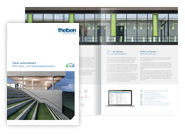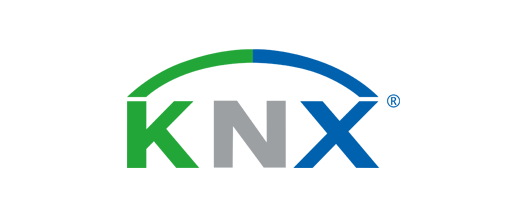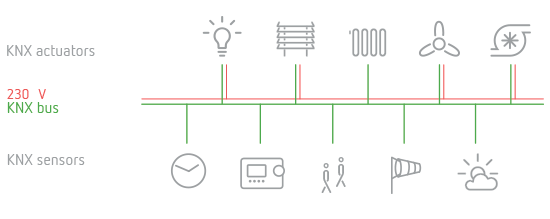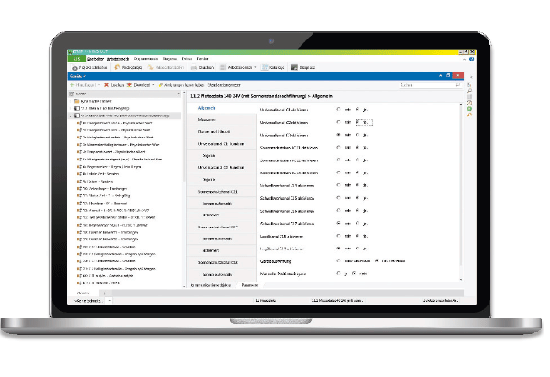
Brochure on KNX home and building control
On nearly 90 pages, you will find practical solution examples around KNX home and building control that are worth knowing.
MIX2 actuators: intelligent, flexible, expandable
In an easily understandable way, our MIX2 videos show you the various advantages of the MIX2 series.
KNX – a technology and its unlimited possibilities
Whether universities, schools, or other administrative and office buildings, nursing homes and hospitals, museums, hotels, or private homes – KNX makes more of it. The advantage of a KNX installation is its versatility. Via KNX, all building functions can be linked, programmed, and controlled. Starting with heating, ventilation, and room climate control, via lighting and shading, up to alarm, safety and information systems. All these functions can be controlled automatically via intelligent sensors, manually at the control units inside the rooms, or centrally via a visualisation – in the house, or in the move via smartphone or tablet.
Theben, KNX and the KNX Association – the fieldbus and its history
KNX stands for "Konnex" or "Connectivity" (connection), and it is a fieldbus for building automation. KNX resulted from merging the European organisations EIBA, EHSA, and BCI, which strived for a common standard of the back then existing field buses. Today, KNX is the global standard for house and building automation (ISO/IEC 14543). Worldwide, there are more than 44,000 trained KNX partners in 125 countries. The directives for KNX technology are defined and regulated by the KNX Association, to which today over 370 companies belong, worldwide. KNX thus stands for extremely high investment and future security. Theben joined the association as one of the first members, and as a member of the Executive Committee, actively influences the development of KNX technology. Since 2015, Theben is also a member of the KNX Technology Committee. Theben – a competent partner all around KNX.
KNX – sensors and actuators, how everything interacts
KNX is like the bodies nervous system, which is equipped with sensors and actuators. Everything the sensors detect is sent to the actuators, as a command. The actuators on their part trigger the desired response: They switch on the light when it gets too dark, they heat when it gets too cold, and they control the blinds, when the sun gets too bright. The topology is extremely versatile: line, tree, or star structures are possible. KNX devices are connected to the KNX bus which in many cases is the also the power supply to the device, for example presence detectors. While in conventional systems control and energy distribution are interconnected, KNX participants communicate using their own line network. The line network of a KNX installation is divided into sections, so-called lines, and structured hierarchically. The lines are logically and physically interconnected via line or area couplers. Each line has a power supply, which can supply up to 64 participants, depending on the individual design. A line can be extended with up to three line amplifiers by further 64 participants each. 15 of these KNX lines make up one area. 15 areas can be linked with each other via an area line, the so-called "backbone". Minus the system components, up to 58,384 KNX devices can be installed in one system.
ETS – the software for every KNX installation
The KNX bus devices communicate via data telegrams. Assignment between the individual participants and configuration of the functions is made by using the so-called ETS, the "Engineering Tool Software". The ETS has been created by the KNX Association and is constantly enhanced. It is the common base of all KNX installations. All KNX devices have to be certified by independent institutions. After successful certification, the device-specific data can be imported into the ETS. In this way, KNX installations can be implemented independent of the manufacturer. Thus, ETS programming of a KNX building installation is as versatile as life itself. To tell when and what should take place and in which room, can be a complex task, which requires foresight and flexibility. The advantage of KNX: Functions of a system can be reprogrammed any time via the ETS.
Costs and benefits – KNX pays off
The question you will hear over and over again, and which you might be interested in as well: KNX – is it worth it? The answer:
a clear yes.
Especially with new buildings, if the building intelligence is
comprehensive, and if numerous functions have to be linked with each other. KNX is suited for private single-family houses, as
well as for administration, office, or industrial buildings.
Even if the initial costs are, in some cases, higher than with a
conventional installation, a KNX installation quickly pays off after the first changes in use. Many functions, such as scene controls,
or central visualisation could not be implemented without bus
technology. More comfort, higher energy efficiency, and a higher quality of life in the long term.






